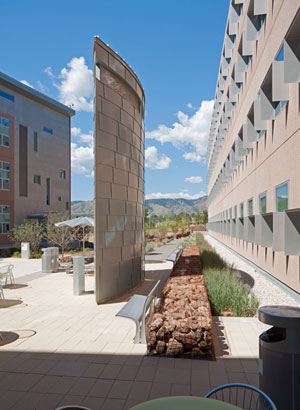Zeroing In on Net-Zero Energy
Round two
Many of these same techniques are being deployed in a 138,000-square-foot expansion of the RSF already under way with the same design-build team. But some of the elements have been subtly tweaked. For example, new details for the precast cladding panels allow more continuous insulation, windows and curtain walls incorporate improved thermal breaks, and the mechanical system includes a more efficient heat-recovery device. According to RNL and Haselden, these and other modifications should make the second phase of construction even more economical than the first. They should also improve energy efficiency: The newer portion of the RSF is expected to have an energy-use intensity of less than 29 kBtus per square foot each year.
 |
The RSF's bid for LEED Platinum includes site strategies such as permeable pavement in courtyards and gabion walls made from rock recovered during excavation for the foundations. Photo: © Frank Ooms |
The performance expectations for both phases of construction are based on exquisitely detailed energy simulations. The studies even take into account RSF features difficult to model with off-the-shelf software, including the radiant slabs, the transpired solar collectors, and the labyrinth. To predict the contribution of these elements to the building's performance, Stantec engineers devised work-arounds that relied on elaborate spreadsheet calculations unique to the project. The result was a model comprehensive enough to convince NREL that the design-build team would be delivering a building matching its proposal.
As a savvy client, NREL recognized that the RSF's success would not entirely be a function of the building's engineering and architecture. Achievement of the ambitious energy conservation targets would also depend on how occupants inhabited the space. So even before issuing its request for proposals, the owner conducted a thorough survey of plug loads (devices that plug into the building's electrical system) in its existing office spaces, including workstation computers, task lights, and refrigerators in break rooms.
It also benchmarked process loads, such as elevators and control systems, and then created stringent guidelines for new equipment. "In many ways we already know how to get the architecture and engineering right," says Andary. "We need to focus more attention on the stuff that plugs into the wall."
The completed first phase of the RSF is now almost entirely occupied and undergoing a measurement and verification process, ending in July, that involves monitoring the building's energy consumption. The design-build team is looking forward to these results, as the last bit of its incentive payment is tied to them. But the team members' keen interest is more than a by-product of the remaining award funds. "As a responsible partner," insists Macey, "we want to know how the building is working."








